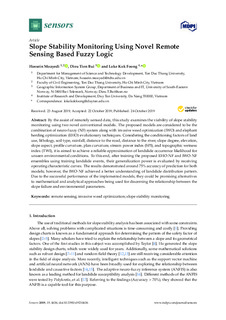Slope Stability Monitoring Using Novel Remote Sensing Based Fuzzy Logic
| dc.contributor.author | Moayedi, Hossein | |
| dc.contributor.author | Tien Bui, Dieu | |
| dc.contributor.author | Foong, Loke Kok | |
| dc.date.accessioned | 2020-01-27T12:58:03Z | |
| dc.date.available | 2020-01-27T12:58:03Z | |
| dc.date.created | 2019-11-12T22:10:05Z | |
| dc.date.issued | 2019 | |
| dc.identifier.citation | Sensors. 2019, 19 (21). | nb_NO |
| dc.identifier.issn | 1424-8220 | |
| dc.identifier.uri | http://hdl.handle.net/11250/2638088 | |
| dc.description | Licensee MDPI, Basel, Switzerland. This article is an open access article distributed under the terms and conditions of the Creative Commons Attribution | nb_NO |
| dc.description.abstract | By the assist of remotely sensed data, this study examines the viability of slope stability monitoring using two novel conventional models. The proposed models are considered to be the combination of neuro-fuzzy (NF) system along with invasive weed optimization (IWO) and elephant herding optimization (EHO) evolutionary techniques. Considering the conditioning factors of land use, lithology, soil type, rainfall, distance to the road, distance to the river, slope degree, elevation, slope aspect, profile curvature, plan curvature, stream power index (SPI), and topographic wetness index (TWI), it is aimed to achieve a reliable approximation of landslide occurrence likelihood for unseen environmental conditions. To this end, after training the proposed EHO-NF and IWO-NF ensembles using training landslide events, their generalization power is evaluated by receiving operating characteristic curves. The results demonstrated around 75% accuracy of prediction for both models; however, the IWO-NF achieved a better understanding of landslide distribution pattern. Due to the successful performance of the implemented models, they could be promising alternatives to mathematical and analytical approaches being used for discerning the relationship between the slope failure and environmental parameters | nb_NO |
| dc.language.iso | eng | nb_NO |
| dc.rights | Navngivelse 4.0 Internasjonal | * |
| dc.rights.uri | http://creativecommons.org/licenses/by/4.0/deed.no | * |
| dc.title | Slope Stability Monitoring Using Novel Remote Sensing Based Fuzzy Logic | nb_NO |
| dc.type | Journal article | nb_NO |
| dc.type | Peer reviewed | nb_NO |
| dc.description.version | publishedVersion | nb_NO |
| dc.rights.holder | © 2019 by the authors. | nb_NO |
| dc.source.pagenumber | 13 | nb_NO |
| dc.source.volume | 19 | nb_NO |
| dc.source.journal | Sensors | nb_NO |
| dc.source.issue | 21 | nb_NO |
| dc.identifier.doi | 10.3390/s19214636 | |
| dc.identifier.cristin | 1746804 | |
| cristin.unitcode | 222,57,1,0 | |
| cristin.unitname | Institutt for økonomi og IT | |
| cristin.ispublished | true | |
| cristin.fulltext | original | |
| cristin.qualitycode | 1 |
Tilhørende fil(er)
Denne innførselen finnes i følgende samling(er)
-
Institutt for økonomi og it [152]
-
Publikasjoner fra CRIStin [3417]

